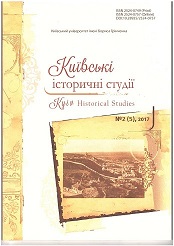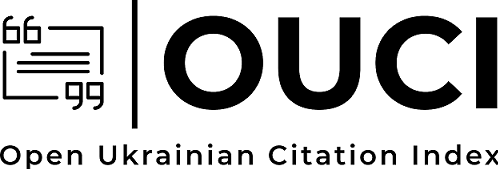AUPCA KYIV FILM STUDIOS AND OLEKSIY KAPPLER’s FILM “RIGHT FOR WOMAN”: STORY OF ONE BAN
DOI:
https://doi.org/10.28925/2524-0757.2017.211Keywords:
Film “Right for Woman”, women’s emancipation, gender policy, AUPCA Kyiv Film Studios, history of the banAbstract
The article addresses the issue of a ban placed on the film “Right for Woman” (Pravo na Zhinku) by Oleksiy Kappler produced in 1930 by the newly established Kyiv Film Studios of the All-Ukrainian Photo Cinema Administration (AUPCA). The author reviews the main difficulties its production faced and the film itself had with assessment by the repertoire committee and shift in the emancipatory ideologemes at the verge of the 1920-30s. The research discusses the insufficiency of the analysis of the phenomenon of the film’s “ban” in the modern historiography. The article suggests viewing the film with the help of the notions “gender conflict” and “culture shock”. Their application makes it possible to uncover a significant layer of the latent information: manifestations of the “men’s protest”, gender conflict of interests, change of the regime’s gender policy, the phenomenon of feminization of medical education, transformation of the institute of family, confrontation between the cinema artist and the state, competition between Kyiv and Odesa Film Studios. The author concludes that the film is a peculiar artistic monument to the Soviet policy of “women’s emancipation” with a significant amount of hidden, forbidden, conflicted, and shocking information. The history of the ban proves that the content and significance of the film can have numerous readings in different historic times and become a marker of the watershed from the 1920s to the 1930s in the Soviet regime’s emancipatory ideologemes. The research shows the necessity to further study the film as a unique historic source on women’s emancipation of the Soviet times.
Downloads
References
Alpers, B. (1930). «Dve zhenshchinу». Kino i zhizn. Cinema and life, 7, 6–7 (in Russian).
Bezruchko, O. (2015). Druhyi period tvorchoi i kinopedahohichnoi diialnosti O. Kaplera na Kyivskii kinofabrytsi naprykintsi 20-kh rr. — per. pol. 30-kh rr. ХХ st. Visnyk KNUKiM, Seriia: Mystetstvoznavstvo, Vyp. 33, 17–24 (in Ukrainian). http://nbuv.gov.ua/UJRN/Vknukim_myst_2015_33_5
Bezruchko, O. (2012). Malovidomi storinky zhyttia i kinopedahohichnoi diialnosti odnoho z fundatoriv «kinoleniniany». Svit sotsialnykh komunikatsii: naukovyy zhurnal (Kyivskyi mizhnarodnyi universytet, Donetskyi natsionalnyi universytet), 8, 167–169 (in Ukrainian).
Borskyi, O. (1929). K.K.F. (pro Kyivsku kinofabryku). Kino. Cinema, 7 (54), 8–9 (in Ukrainian).
Burdie, P. (2015). Refleksyvna sotsiolohiia. Pier Burdie, Loik Vakan; per. z anhl. (A. Riabchuk, Trans.), K., Meduza, p. 224 (in Ukrainian).
Burshtein, V. (1928). Pro klubnyi prokat kinofilmiv. Radianske mystetstvo, 5, 11 (in Ukrainian).
Velyke lykho malenkoi zhinky. (1929). Kino, 5 (53), 8–9 (in Ukrainian).
Voronina, M. S. (2014). P. Anhelina, M. Demchenko ta in.: ukrainska elita 1930-kh chy ni? Naukovi pratsi istorychnoho fakultetu Zaporizkoho universytetu, XXXVIII, 157–161 (in Ukrainian).
Golod, S. I. (1989). Voprosy semii i polovoi morali v diskussiiakh 20-kh godov. In edit. by O. Tselikovoi, R. Petropavlovskogo. M., IF AN SSSR. Marksistskaia eticheskaia mysl v SSSR (20-yie — pervaia polovina 30-kh gg.), pp. 244–268 (in Russian).
Derzhavnyi arkhiv Dnipropetrovskoi oblasti. F. 11, Оp. 1, Spr. 301, 26 Arк.
Derzhavnyi arkhiv Kharkivskoi oblasti. F. r-865, Оp. 1, Spr. 447, Аrк. 8–12.
Zhuravliova, T. V. (2016) . Melodramatyzm v ukrainskii ekrannii kulturi. Doctoral thesis. Kyiv, 208 p. (in Ukrainian).
Zdravomyslova, I., Tomkina, A. (2004). Gosudarstvennoie konstruirovaniie gendera v sovetskom obshchestve. Zhurnal issledovanii sotsialnoi politiki, V. 1, 3–4, 299–321 (in Russian).
Irak, O. (1928). Zhinka na ekrani. Кіnо, 3(39), 12 p. (in Ukrainian).
Kapler A. (1966). Rasskazy o tvorcheskom puti. Biuro propagandy sovetskogo kinoiskusstva (in Russian). http://istoriya–kino.ru/books/item/f00/s00/z0000019/st006.shtml
Labur, O. (2013) «Zhinoche rozkripachennia» v Radyanskii Ukraini (1920–1930 rr.): osoblyvosti formuvannia dzherel. Intelihentsiia i vlada, 29, 181–190 (in Ukrainian).
Lektsiia i kinopokaz «Pravo na zhinku — pravo na parandzhu» Dovzhenko-Tsentru za pidtrymky Fondu Rozy Liuksemburh v Ukraini v ramkakh proektu «Kulturfilm: Femme Mute» (in Ukrainian). https://www.evensi.com/Кінолекторій-Культурфільм-femme-mute-plivkafemme-mute-plivka/187822388
Lytvynova O. U. (2009) Muzyka u kinematohrafii Ukrainy: kataloh. K., Lohos, V. 1: Avtory muzyky khudozhnio-ihrovykh filmiv, yaki stvorylysia na kinostudiiakh Ukrainy, 453 p. (in Ukrainian).
Loiko, H. (sichen, 1930). Fabryka pratsiuie. Kino, 1 (73), 9 (in Ukrainian).
Lukov, V. A., Kirillina, V. N. (2005). Gendernyi konflikt: sistema ponyatii. Znaniie. Ponimaniie. Umeniie, 1, 86–101 (in Russian).
Markova, S. D. (2015). Akkulturatsiia: k teorii voprosa. Sovremennyie nauchnyie issledovaniia i innovatsii, 12 (in Russian). http://web.snauka.ru/issues/2015/12/60006
Myslavskyi, V. (2015). Pobutovi filmy v ukrainskomu kinematohrafi 1927–1930-kh. Visnyk Kharkivskoi derzhavnoi akademii dyzainu i mystetstv, 8, 91–95 (in Ukrainian).
Nashi dosiahnennia. (1934). Komunarka Ukrainy, Ukraine, 1, 7 (in Ukrainian).
Novin, S. (1929). «Dvi zhinky» (novyi film VUFKU). Radyanske mystetstvo, 6 (25), 9 (in Ukrainian).
Sakhadeo, J., Zanka, R. (in edit.). (2007). Ogranichennoie osvobozhdeniie: gender, revoliutsiia i parandzha v povsednevnoi zhizni v Sovetskom Uzbekistane (in Russian). http://caa-network.org/archives/8785
Poiizd-liliput: [red. st.]. (sichen, 1930). Kino. 1 (73), 14. (in Ukrainian).
Prezentatsiia kinopokazu filmu Natsionalnym tsentrom Oleksandra Dovzhenka u kinoteatri «Lira» v 2015 rotsi (in Ukrainian). http://www.dovzhenkocentre.org/event/150/
Prymachenko, Ya. Ukrainske kino 1920-kh rokiv u poshukakh vlasnykh tem ta smysliv (in Ukrainian). http://uamoderna.com/md/prymachenko–ukrainian–cinema
Rezoliutsiia narady pry Upravlinni politosvity Narkomosu URSR pro stan polipshennya khudozhnoi roboty VUFKU. Lystuvannia z VUFKU. TSDAVO Ukrayiny. F. 166, Op. 6, T. V, Spr. 8601, Ark. 48 (in Ukrainian).
Rosliak, R. (2013). Vplyv ukrainizatsiinykh protsesiv na kadrovu polityku v ukrainskomu kinematohrafi (1920-ti — pochatok 1930-kh rr.) (in Ukrainian). http://nbuv.gov.ua/UJRN/Nvkkarogo_2013_13_9
Skoryna, L. (2011). Spetsyfika kinopovistei Mykoly Bazhana i Yuriia Yanovskoho na tli rozvytku ukrainskoi kinodramaturhii 30-kh rokiv XX stolittia. Cherkasy, Literaturoznavstvo. Folklorystyka.
Kulturolohiya: zbirnyk naukovykh prats, V. 10, 17–30 (in Ukrainian).
Sobutskyi, M. (2008). Vizualnist — 1931: SRSR ta Ukraina. Naukovi zapysky NAUKMA. Seriіa: Teoriia ta istoriia kultury, 75, 31–38 (in Ukrainian).
Stalin, I. V. (1951). Sochineniia. 1932-1934 gg., Vol. 13. M., Gos. izd. pol. lit-ry (in Russian). http://grachev62.narod.ru/stalin/t13/t13_39.htm
Stvorymo filmy pro heroichnykh liudei sotsializmu. (1935). Radyanske mystetstvo, 3–4, 10 (in Ukrainian).
Stolar, V. (1930). Dyskutna piesa. Radіanske mystetstvo, 1 (31), 4 (in Ukrainian).
Ferro, M. (1993). Kino i istoriia. Voprosy istorii, 2, 47–58 [in Russian].
Tsentralnyi derzhavnyi arkhiv vyshchykh orhaniv vlady ta upravlinnia Ukrainy (TsDAVO Ukrainy). F. 166, Op. 6, T. VI, Spr. 10113, Ark. 112, 384 (in Ukrainian).
TsDAVO Ukrainy. F. 166, Op. 6, T. V, Spr. 8601, Ark. 48 (in Ukrainian).
TsDAVO Ukrainy. F. 1238, Op. 1, Spr. 183, Ark. 35 (in Ukrainian).
Shcho bude robyty ukrainske kino 1928–1929 rr.(oriientovanyi plan VUFKU). (veresen, 1928). Kino, 9 (45), 17–22 (in Ukrainian).
Shcho stavytyme Kyivska kinofabryka? (traven, 1929). Kino, 9–10 (56–57), 14 (in Ukrainian).
Shchurko, T. (2014), «Khudzhum»: zhenskaia emansipatsiia v period rannikh sovetskikh «eksperimentov» v Sovetskoi Kirgizii (1918–1930 gg.) 9in Russian). http://www.art–initiatives.org/ru/content/hudzhum–zhenskaya–emansipaciya–v–period
Published
How to Cite
Issue
Section
License
Copyright (c) 2018 Kyiv Historical Studies

This work is licensed under a Creative Commons Attribution-NonCommercial-ShareAlike 4.0 International License.
Authors who publish in this journal retain the right of authorship of the work and give to the journal right of first publication of this work under the conditions of Creative Commons: Attribution-NonCommercial-ShareAlike 4.0 International (CC BY-NC-SA 4.0), which allows others freely distribute the work published with reference to the authors of the original work and the first publication of this magazine.














